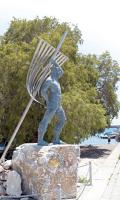 The
monument
of the
Unknown
Sailor, port
of Kalamata The port used to be the most important source of Kalamata’s livelihood.
It was the cornerstone of the city’s commercial development and urban expansion from the castle to the beach. Up until the early 19th century, of course, the coast was a deserted strip of marshland, lakes and bush. The first settlement (at the western end of the beach), Analipsi, dates back to pre-revolutionary times and was originally composed of warehouses, shops, etc. The customs office, or Douana, also used to be located there –thus the name Palia Douana, or Old Douana–, while there were also tanneries, after which the area is also known as Tabakika. Sea transport was restricted to the summer months and conducted on boats or barges, while in the winter goods and passengers would use the natural Bay of Almyros. 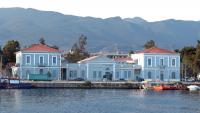 The customs
office, or
Douana In 1860 the eastern end of the coast became developed into a new settlement called «Neai Kalamaea». Three years later the customs office was transferred here, to the spot where Faron street ends, and the area was named Nea (New) Douana. The foundation stone of the port was laid in 1882 and the project was completed in 1901. Meanwhile, two new roads were constructed leading from the coast to Kalames, present-day Aristomenous (1871) and Faron (in the 1890s), and the railroad leading from the city to the coast was laid down in the early 20th century. Construction on the present-day customs office was completed in 1911. 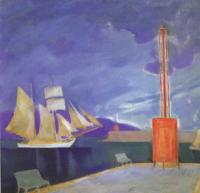 ∫. Parthenis,
Δhe port of
Kalamata A central spot on the coastal strip is commanded by Teloneio (Customs Office) square, dominated by the Customs Office–Port Authority compound, which comprises a cluster of two-storey and single-storey buildings in the eclectic style (1910-1930). The ground floors are built in a shape and there are also some neoclassical features to be seen on the other levels, such as arches with columns and entablatures framing doors or windows, balconies with sculpted marble consoles, ornate railings, etc. 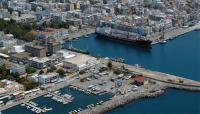 The port of Kalamata West of the Teloneio square lies the eclectic building of the Autonomous Raisin Organisation. It is a two-storey, tile-roofed building of the beginning of the 20th century, influenced by the French architecture. It is comprised by two mass-structures of the same morphology but of different size. It houses on the ground floor a store and on the first floor a warehouse. Southwest of the Customs Office, on the port, one can see the mass of the Evangelistria Mills of Messenia SA rising up in the distance. 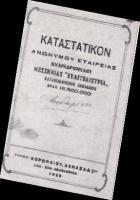 Evangelistria mills of Messinia West of the Teloneio Square will lead us, successively, to the areas of Analipsi and the homonymous church, the Marina with its luxurious yachts and rows of restaurants, the Nedon River Delta, the Sfageion Municipal Stadium, the Kordias settlement and the archaeological site at Akovitika. If we head east from Teloneio square towards Navarinou street, we will come across a number of early 20th century neoclassical buildings, remnants of a bygone era, when the port of Kalamata was a vibrant hub and the coast was not just a commercial, industrial and financial center, but a busy social hub as well, with luxury hotels and fine restaurants. 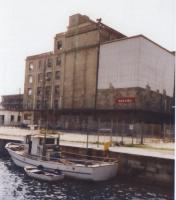 Evangelistria mills of Messinia Southeast of the Panellinion are the NOK and Aeolos Nautical clubs, and the DEPAK Arts School, which is on the corner of Navarinou and Riga Feraiou. This building is a typical two-storey, tileroofed neoclassical (1890-1910) structure, built rather simply and displaying some impressive sculpted cornices. Further east we come across the Municipal Stadium (north of Navarinou), the Church of Anastasi, the community of Nikitara and the conference centers of the Elite and Filoxenia hotels. The 2,5 kilometer beach here is a good spot for a swim or a stroll. There is a broad walkway lined with palm trees and flowerbeds that runs in parallel to the beach. Generally, across the coastal strip on Navarinou street, an area full of life especially in the summer, there are numerous cafes, ouzeri, fish taverns and bars. At night the air is dominated by the sound of revelers, while during the day and thanks to the biological cleaning system, locals and visitors can enjoy a swim at this clean pebbled beach. 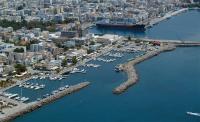 Marina 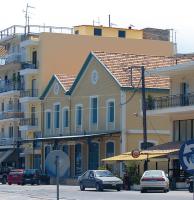 The building of
the Autonomous
Raisin
Organisation |